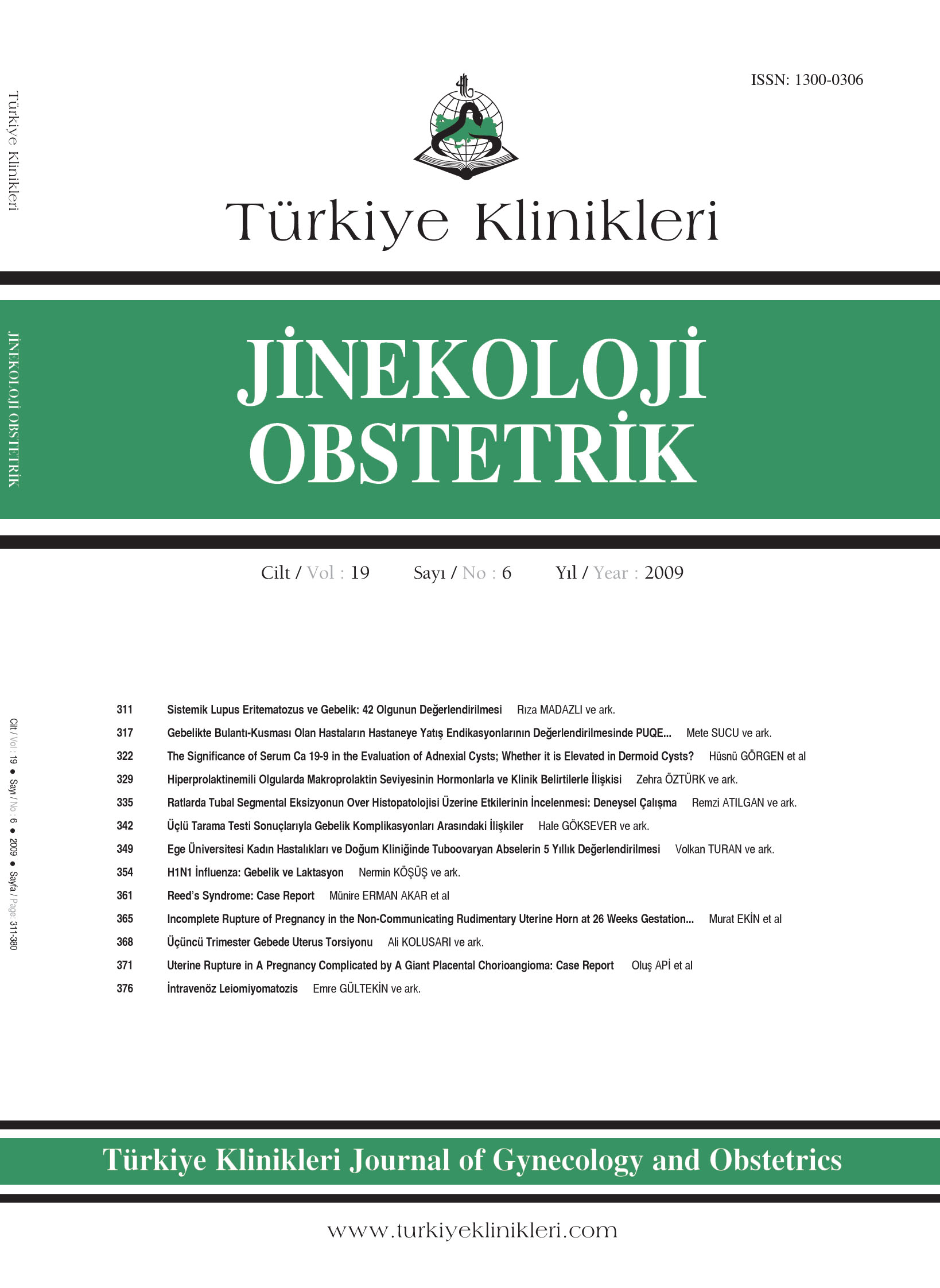Open Access
Peer Reviewed
ORIGINAL RESEARCH
3613 Viewed1865 Downloaded
Systemic Lupus Erythematosus and Pregnancy: Evaluation of 42 Cases
Sistemik Lupus Eritematozus ve Gebelik: 42 Olgunun Değerlendirilmesi
Turkiye Klinikleri J Gynecol Obst. 2009;19(6):311-6
Article Language: TR
Copyright Ⓒ 2025 by Türkiye Klinikleri. This is an open access article under the CC BY-NC-ND license (http://creativecommons.org/licenses/by-nc-nd/4.0/)
ÖZET
Amaç: Sistemik lupus eritematozus (SLE) tanısı konmuş gebelerin maternal ve fetal sonuçlarını irdelemek ve obstetrik sonuçlar üzerine etkili prognostik faktörleri değerlendirmektir. Gereç ve Yöntemler: İstanbul Üniversitesi Cerrahpaşa Tıp Fakültesi Kadın Hastalıkları ve Doğum Ana Bilim Dalında Ocak 2002-Aralık 2007 tarihleri arasında takipleri ve doğumları gerçekleştirilen 42 SLE ve gebelik olgusu retrospektif olarak irdelendi. Bulgular: Gebelerin ortalama yaşı 28.6 yıl ve nulliparite oranı %45.2 olarak belirlendi. Gebelikte SLE aktivasyonu, olguların %9.5'unda gözlendi. Lupus antikoagülanı, antikardiyolipin immünglobulin (Ig) G ve IgM antikorları gebelerin sırasıyla %33.3, %16.6 ve %19'unda pozitif olarak saptandı. Ortalama doğum haftası 36.9 ± 4.2 ve ortalama doğum kilosu 2.750 ± 844 g olarak tespit edildi. Fetal kayıp, fetal gelişim kısıtlılığı, preeklampsi ve erken doğum oranları sırasıyla %7.1, %14.3, %2.4 ve %23.1 olarak belirlendi. Uterin arter Doppler tetkikinde anormallik saptanan olgularda olumsuz obstetrik sonuçlar anlamlı olarak daha yüksek oranda saptandı. Antifosfolipid antikorlar, böbrek tutulumu ve lupus aktivasyonunun olumsuz obstetrik sonuçlar üzerine anlamlı bir etkisinin olmadığı belirlendi. Sonuç: Ekip anlayışı içinde, konularında deneyimli romatolog ve doğum hekimlerinin birlikte çalışması, SLE'li gebeliklerde anne ve fetus açısından olumlu sonuçların elde edilebilmesi için zorunludur.
Amaç: Sistemik lupus eritematozus (SLE) tanısı konmuş gebelerin maternal ve fetal sonuçlarını irdelemek ve obstetrik sonuçlar üzerine etkili prognostik faktörleri değerlendirmektir. Gereç ve Yöntemler: İstanbul Üniversitesi Cerrahpaşa Tıp Fakültesi Kadın Hastalıkları ve Doğum Ana Bilim Dalında Ocak 2002-Aralık 2007 tarihleri arasında takipleri ve doğumları gerçekleştirilen 42 SLE ve gebelik olgusu retrospektif olarak irdelendi. Bulgular: Gebelerin ortalama yaşı 28.6 yıl ve nulliparite oranı %45.2 olarak belirlendi. Gebelikte SLE aktivasyonu, olguların %9.5'unda gözlendi. Lupus antikoagülanı, antikardiyolipin immünglobulin (Ig) G ve IgM antikorları gebelerin sırasıyla %33.3, %16.6 ve %19'unda pozitif olarak saptandı. Ortalama doğum haftası 36.9 ± 4.2 ve ortalama doğum kilosu 2.750 ± 844 g olarak tespit edildi. Fetal kayıp, fetal gelişim kısıtlılığı, preeklampsi ve erken doğum oranları sırasıyla %7.1, %14.3, %2.4 ve %23.1 olarak belirlendi. Uterin arter Doppler tetkikinde anormallik saptanan olgularda olumsuz obstetrik sonuçlar anlamlı olarak daha yüksek oranda saptandı. Antifosfolipid antikorlar, böbrek tutulumu ve lupus aktivasyonunun olumsuz obstetrik sonuçlar üzerine anlamlı bir etkisinin olmadığı belirlendi. Sonuç: Ekip anlayışı içinde, konularında deneyimli romatolog ve doğum hekimlerinin birlikte çalışması, SLE'li gebeliklerde anne ve fetus açısından olumlu sonuçların elde edilebilmesi için zorunludur.
ABSTRACT
Objective: To analyze maternal and fetal outcomes in pregnant patients with systemic lupus erythematosus (SLE) and to evaluate prognostic factors. Material and Methods: We present a retrospective study of the 42 consecutive cases of SLE and pregnancy followed and delivered during the period from 2002 to 2007 in Istanbul University Cerrahpaşa Medical Faculty Obstetrics and Gynecology Department. Results: The mean patient age was 28.6 years and the nulliparity rate was 45.2%. Disease flare up occurred in 9.5% of patients. Lupus anticoagulants, anticardiolipin IgG and IgM antibodies were positive in 33.3%, 16.6% and 19% of patients respectively. Mean gestational age at delivery was 36.9 ± 4.2 and mean birthweight was 2.750 ± 844 grams. Stillbirth, fetal growth restriction, preeclampsia and preterm delivery rates were 7.1%, 14.3%, 2.4% and 23.1% respectively. Cases with uterine artery Doppler abnormalities had significantly poorer obstetric outcomes. Antiphospholipid antibodies, renal involvement and lupus activation did not have any significant influence on poor obstetric outcome. Conclusion: Adequate pregnancy follow-up and delivery care by a multidisciplinary setting with a maternal-fetal medicine specialist and a rheumatologist is mandatory for good maternal and fetal outcomes.
Objective: To analyze maternal and fetal outcomes in pregnant patients with systemic lupus erythematosus (SLE) and to evaluate prognostic factors. Material and Methods: We present a retrospective study of the 42 consecutive cases of SLE and pregnancy followed and delivered during the period from 2002 to 2007 in Istanbul University Cerrahpaşa Medical Faculty Obstetrics and Gynecology Department. Results: The mean patient age was 28.6 years and the nulliparity rate was 45.2%. Disease flare up occurred in 9.5% of patients. Lupus anticoagulants, anticardiolipin IgG and IgM antibodies were positive in 33.3%, 16.6% and 19% of patients respectively. Mean gestational age at delivery was 36.9 ± 4.2 and mean birthweight was 2.750 ± 844 grams. Stillbirth, fetal growth restriction, preeclampsia and preterm delivery rates were 7.1%, 14.3%, 2.4% and 23.1% respectively. Cases with uterine artery Doppler abnormalities had significantly poorer obstetric outcomes. Antiphospholipid antibodies, renal involvement and lupus activation did not have any significant influence on poor obstetric outcome. Conclusion: Adequate pregnancy follow-up and delivery care by a multidisciplinary setting with a maternal-fetal medicine specialist and a rheumatologist is mandatory for good maternal and fetal outcomes.
MENU
POPULAR ARTICLES
MOST DOWNLOADED ARTICLES





This journal is licensed under a Creative Commons Attribution-NonCommercial-NoDerivatives 4.0 International License.










